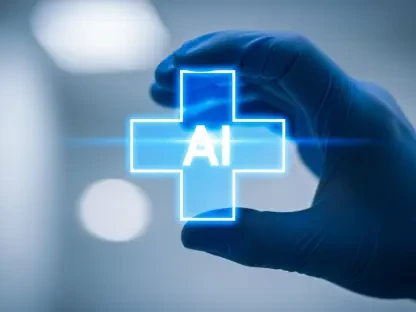The healthcare sector stands at a critical juncture where artificial intelligence (AI) promises groundbreaking advancements in patient care and operational efficiency, yet it simultaneously exposes organizations to unprecedented cybersecurity risks. With cyberattacks on healthcare entities increasing by over 30% annually in recent years, as reported by industry studies, the integration of AI into medical systems has become a double-edged sword. This review delves into the transformative potential of AI as a defensive tool and a threat vector, evaluating its features, performance, and implications within the complex landscape of healthcare cybersecurity.
The Context of AI in Healthcare Security
AI has rapidly emerged as a cornerstone of innovation in healthcare, driving improvements in diagnostics, personalized medicine, and administrative workflows. However, its adoption has also ushered in sophisticated cyberthreats that exploit vulnerabilities in data-rich environments. As healthcare organizations manage vast amounts of sensitive patient information, the stakes for securing these systems have never been higher, prompting a closer examination of AI’s dual role in this domain.
The urgency to address cybersecurity challenges is compounded by the evolving nature of attacks, which now leverage AI to bypass traditional defenses. This review aims to unpack the technology’s capabilities in fortifying healthcare systems against breaches while also scrutinizing how it can be weaponized by malicious actors. By exploring real-world impacts and emerging trends, a comprehensive understanding of AI’s place in this critical sector takes shape.
Analyzing AI’s Features and Performance in Healthcare Cybersecurity
AI as a Protective Mechanism
AI’s ability to enhance cybersecurity in healthcare lies in its capacity to analyze massive datasets in real time, identifying anomalies that signal potential threats. Machine learning algorithms, for instance, can detect unusual network activity indicative of a breach, enabling swift intervention before damage escalates. This predictive power is particularly vital in an industry where downtime or data loss can directly impact patient safety.
Beyond detection, AI automates responses to cyber incidents, reducing the burden on human teams and minimizing response times. Systems powered by this technology can isolate affected networks, deploy patches, and even simulate attack scenarios to strengthen defenses proactively. Such automation proves invaluable for understaffed hospitals or clinics facing resource constraints, offering a scalable solution to persistent security challenges.
The performance of AI-driven security tools has shown promising results, with some platforms reducing false positives in threat detection by significant margins compared to traditional methods. However, their effectiveness often hinges on the quality of data and the continuous tuning of algorithms, underscoring the need for robust implementation strategies. As threats evolve, these systems must adapt to maintain their edge in safeguarding critical infrastructure.
AI as a Source of Vulnerability
On the flip side, AI presents a formidable challenge when exploited by cybercriminals targeting healthcare entities. Malicious actors use AI to craft advanced malware capable of evading conventional antivirus software, tailoring attacks to exploit specific weaknesses in hospital systems. Such precision increases the likelihood of successful breaches, amplifying the potential for data theft or operational disruption.
Phishing schemes, too, have grown more sophisticated with AI’s assistance, as algorithms generate highly convincing messages that deceive even cautious staff. The rapid evolution of these threats means that defenses often lag, leaving organizations vulnerable to novel attack vectors. This dynamic illustrates a cat-and-mouse game where adversaries continuously refine their tactics, challenging the resilience of existing security frameworks.
A notable concern is the accessibility of AI tools to bad actors, enabling even those with limited technical expertise to launch complex attacks. This democratization of cyberthreat capabilities heightens the risk profile for healthcare providers, particularly smaller entities lacking advanced countermeasures. Addressing this vulnerability demands not only technological innovation but also a cultural shift toward heightened awareness and preparedness across the sector.
Emerging Innovations and Regulatory Shifts
Recent developments in AI-driven healthcare security point to a growing emphasis on adaptive technologies that anticipate threats rather than merely react to them. Innovations such as federated learning allow organizations to train AI models collaboratively without sharing sensitive data, mitigating privacy risks while enhancing threat detection capabilities. These advancements signal a move toward more resilient systems tailored to the unique needs of medical environments.
Regulatory scrutiny is also intensifying, with policymakers pushing for stricter guidelines on AI deployment in healthcare to ensure accountability and transparency. Frameworks being developed from this year onward aim to balance innovation with security, mandating regular audits and risk assessments for AI systems. While these measures are essential, they must avoid stifling progress, striking a delicate equilibrium in a fast-evolving field.
Industry behavior reflects an increasing recognition of the need for comprehensive security strategies that integrate AI responsibly. Collaborative efforts among stakeholders—ranging from technology vendors to healthcare providers—are fostering the development of shared best practices. This collective approach is crucial for addressing the multifaceted risks AI introduces, ensuring that its benefits are realized without compromising patient trust or safety.
Real-World Impacts and Lessons Learned
Examining practical applications of AI in healthcare cybersecurity reveals both its strengths and its pitfalls through high-profile incidents. The ransomware attack on Change Healthcare in early 2024, perpetrated by the Black Basta group, exposed glaring weaknesses when outdated systems lacking multi-factor authentication allowed hackers to disrupt nationwide claim processes. The aftermath, which saw a hefty ransom payment, highlighted the dire consequences of neglecting basic security protocols in an AI-driven threat landscape.
Contrasting this, smaller healthcare entities have demonstrated success in leveraging AI to bolster defenses despite limited budgets. For instance, community hospitals employing AI-based monitoring tools have reported early detection of phishing attempts, preventing potential breaches. These varied outcomes across different scales of operation emphasize that while AI offers powerful solutions, its efficacy depends heavily on tailored implementation and ongoing maintenance.
Case studies also reveal a broader lesson: the human element remains a critical factor in cybersecurity. Training staff to recognize AI-generated threats, such as deepfake communications, is as important as deploying cutting-edge technology. These real-world examples underscore the necessity of a holistic approach, combining AI tools with robust policies and education to fortify healthcare systems against diverse risks.
Challenges in Harnessing AI for Security
Despite its potential, integrating AI into healthcare cybersecurity faces significant obstacles, including technical limitations and disparities in organizational resources. Many legacy systems in medical facilities are incompatible with modern AI solutions, requiring costly upgrades that smaller providers struggle to afford. This gap creates uneven protection levels across the industry, leaving some entities more exposed to attacks.
Regulatory inconsistencies further complicate the landscape, as differing standards across regions hinder the adoption of uniform security practices. Without cohesive guidelines, organizations may prioritize compliance over comprehensive risk management, potentially overlooking critical vulnerabilities. Bridging these gaps necessitates coordinated efforts to establish accessible frameworks that support AI integration without imposing undue burdens.
Another pressing challenge lies in addressing the ethical implications of AI, particularly concerning data privacy. Ensuring that AI systems adhere to stringent standards while handling sensitive patient information is paramount to maintaining public trust. Ongoing initiatives to develop ethical guidelines and update protocols aim to mitigate these concerns, but sustained commitment from all stakeholders is essential to navigate this complex terrain.
Final Reflections and Path Forward
Reflecting on this evaluation, AI stands as both a revolutionary force and a formidable challenge in healthcare cybersecurity during the period under review. Its capacity to enhance threat detection and automate responses marks a significant leap forward, yet its exploitation by cybercriminals reveals critical vulnerabilities that demand urgent attention. The balance between leveraging AI’s benefits and mitigating its risks emerges as a central theme in assessing its overall impact.
Looking ahead, healthcare organizations must prioritize the development of adaptive strategies that evolve alongside AI-driven threats. Investing in staff training to recognize sophisticated attacks, coupled with the adoption of scalable AI security tools, offers a viable path to resilience. Collaborative efforts to standardize regulations and share best practices also hold promise for creating a more secure ecosystem.
Ultimately, the journey of integrating AI into healthcare security points to a future where continuous innovation must be matched by unwavering vigilance. By fostering a culture of cyber resilience and committing to regular system updates, the sector can harness AI’s transformative potential while safeguarding against its darker possibilities. This dual focus remains the cornerstone for navigating the evolving landscape of healthcare cybersecurity.









